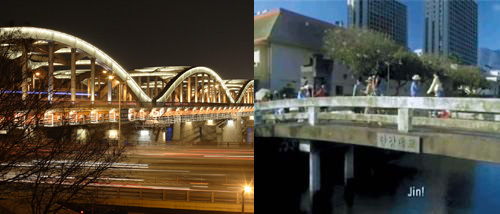Korea Herald
U.S. dramas distort S. Korea imageBy Song Sang-ho | Published October 24, 2010
Many images of South Korea in hit American television series have been “distorted,” raising concerns over their detrimental impact on the country’s overall image, a ruling party lawmaker pointed out Thursday.
Rep. Hong Jung-wook of the Grand National Party said that shows such as “Lost,” “24” and “Crime Scene Investigation,” each of which has been watched by hundreds of millions of people, including Koreans, have shown images that are far from reality.
He made the mention during a parliamentary audit of the Foreign Ministry at the National Assembly, offering a series of examples in which the country was wrongly depicted.
One example is “Lost,” which has gained much popularity here thanks to Korean-born actress Kim Yun-jin. In it, the Han River, regarded as one of the iconic landmarks in the capital of Seoul, was described as a small stream in a village, the lawmaker said. The 1-kilometer-long bridge over the river was shown as an old small bridge, he added.
[ The image of the Han River Grand Bridge in the U.S. television series “Lost” (right photo) and its actual appearance ]
In another scene, a fishing village in Namhae, South Gyeongsang Province, was described as if it were located in Southeast Asia. In the scene, there is a villager wearing a traditional Vietnamese hat and a small sailboat, which can hardly be seen in Korea given its shape and size, was also shown, Hong said.
Also in the television series, a person seen drinking soju, a traditional Korean alcoholic beverage, uses a glass different from the typical Korean glass for the drink. Korean houses and Buddhist temples were also different from those commonly seen here.
“In short, it was a mix-up of elements from China, Japan and Southeast Asia,” said Hong in a press release.
In the TV series “24,” a scene where a person suffers harsh torture in Seoul is shown, which could tarnish the overall image of the capital city even though it was a fictional one, Hong said.
In “CSI,” there was a scene of a Korean community in the United States where a North Korean song regarding an allegiance to the communist state’s ruling Workers’ Party was played as background music.
“Given the enormous impact of popular culture, the images that people have about South Korea will be more similar to those represented in the popular culture rather than images related to the hosting of the Group of 20 summit or the exporting of the nuclear reactors,” Hong said.
“The Foreign Ministry has underscored superficial ‘soft power diplomacy’ and ‘culture diplomacy.’ However, it needs to make substantial efforts to leave a good national image in the minds of the world’s people.”
An Bo-seob, professor of public relations and advertising at Sookmyung Women’s University, said the country could utilize Hallyu, the pan-Asian popularity of Korean culture, to promote the positive image of the country.
“People abroad vicariously experience Korea through the dramas. Thus, the dramas play a crucial role in making images of a country for the general public,” he said.
“It would be efficient for us to highlight the advancement and development our nation has achieved through Hallyu as it would be difficult for us to review their synopses (before the dramas are aired).”
QUESTIONS~
1. Can you think of some recent TV shows that have discussed Korea (in any aspect, whether news pieces or Korean people, lifestyle or culture)?
a. Was the tone positive or negative?
b. Was the coverage thorough? Accurate? Incomplete? Misleading?
c. Was the way in which it portrayed Korea stereotypical or representative of how things really are?
2. If you’ve ever witnessed a poor or unfavorable portrayal of Korea, why do you think it was so? Is there a “right way” or “wrong way” to confront or address it? Please explain.
3. This was recently said about Korea:
“With the G-20 Summit approaching, all eyes are focusing on Seoul. The Korean economy has been growing rapidly over the past couple of years and it now ranks 9th in the world in terms of export volume. However, Korea’s national brand image still lags behind. According to criteria on national branding developed by the Samsung Economic Research Institute and the Presidential Council on Nation Branding, Korea’s national brand ranked 19th in terms of substance and 20th in terms of image.”
excerpted from Korea’s national brand needs to be improved by Yoon Chang-hee (Korea JoongAng Daily, Nov. 1, 2010)
b. Could they do anything else to improve it?
c. Should the burden of the “good ambassador” rest entirely on the marketing, advertising and public relations groups working for the Korean government? Who else?






